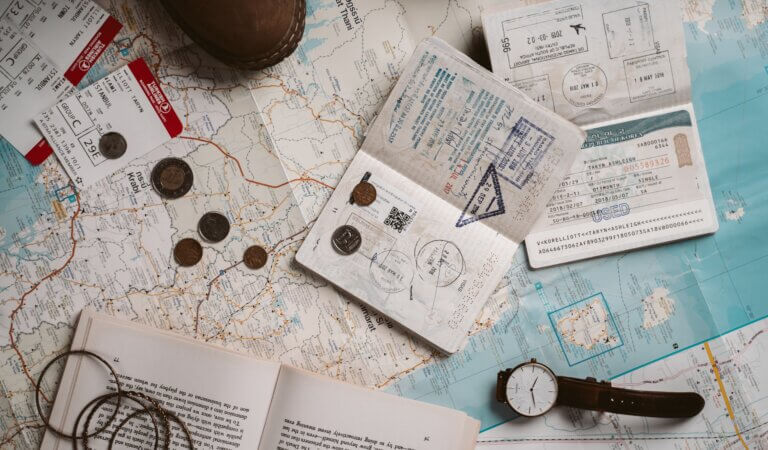How to Travel More with a Full-Time Job: 16 Best Strategies
Wondering how you can travel more with a full-time job? This article has got you covered.
With the rise of influencers and bloggers who seem to live glamorous lives jet-setting around the world, it might be tempting to think that travelling requires quitting your job and regular life. However, that’s not necessary or realistic for many.
You may have other commitments at home that prevent you from dropping everything to leave. Additionally, you might actually enjoy your job and want to achieve professional goals alongside personal travel ambitions.
Or perhaps you simply love your routines and home life and are not prepared to sacrifice them for a nomadic lifestyle, which is completely fair!
Personally, I have visited over 20 countries while maintaining a full-time job. My professional life is important to me, as it funds my travels. I utilise many of the strategies featured in this article.
From maximising your weekends and public holidays to considering work relocation or negotiating more paid leave, there are numerous ways you can travel more with a full-time job.
Disclosure: Some of the links below are affiliate links, which means that at no additional cost to you, I may earn a small commission if you click through and make a purchase. Please note, I only recommend products and services that I know and love. Read full Privacy Policy here.
16 Strategies to Travel More with a Full-Time Job
Prioritise Travel
There is a saying on prioritisation that really resonates with me: ‘You can have anything, but you can’t have everything.’ I think it reflects the reality of human experience: we can achieve many of the things that we want, but not all at the same time.
Ultimately, if you want something, whether it’s travel or something else, you need to make it a priority in your life. It needs to be top of mind and guide your decision-making around how you invest your time and energy.
If your goal is to travel while holding down a full-time job, then be sure to prioritise it in your free time. This may mean occasionally skipping family and friends’ get-togethers, not spending money on other nice things, or not pursuing other hobbies to free up the precious time for travel.
Prioritising travel also means that you need to overcome any obstacles that might prevent you from doing it. For example, you may need to budget better to achieve your goals or organise your time more effectively.
If this sounds a little intense, don’t worry. Your priorities change throughout your life. There might come a time when travel takes a backseat while other things take precedence.
Set Travel Goals
Once you decide that travel is a priority in your life, the next step is to set your travel goals. Make these realistic and achievable with the resources, mainly time and money, that you have.
Personally, with so many destinations on offer and constant bombardment of travel advertising, it’s sometimes hard to choose where to go for your next trip. However, a choice needs to be made to actually make things happen.
When thinking about your travel goals, I recommend starting with your bucket list, if you have one. Be sure to include some big-ticket items in your goal setting to keep yourself motivated to work hard and save money for them.
If you don’t have a bucket list, no worries. Focus on your dream destinations so you don’t put them off indefinitely. You never know what the future holds, and you don’t want to have any regrets in the future.
Plan Your Year Ahead
One of the joys of travel is spontaneous interactions and experiences that you never planned for. However, if you would like to travel more while working full-time, you need to become a meticulous planner to make the most of the limited free time.
Once you set your travel goals, take a look at the calendar for the year. I prefer to do this in either late December or early January, but it’s never too late or too early to go through this exercise.
Take note of any public holidays that you may be able to take advantage of and decide on when you would like to go away. Once you have an idea of the timings for your travel, request your leave at work.
For bigger trips, especially during popular holiday times, it’s best to do this as far in advance as possible. Otherwise, you might miss out on the leave as your colleagues may want to take time off at the same time.
Take Your Paid Leave
This might sound like an obvious suggestion, but many people simply do not take the days of paid leave to which they are entitled. Even if you’re not using it for travelling, it’s a mistake not to use it.
Firstly, why would you not take advantage of your employer paying you to enjoy some time off? It’s there for a reason. Ultimately, you will be better employee if you take time to rest, recharge and have new experiences.
Secondly, your company or colleagues will not remember you for stoically working without holidays. Nobody values this type of ‘sacrifice’.
Lastly, nobody ever regrets not spending more time in the office on their deathbed. So, check your annual leave allowance for this work year and be sure to fully utilise it.
Use Your Weekends
We all have 52 weekends in a year, which translates into 104 days that we can use for pretty much anything we want. You can easily use a good chunk of this time to travel more while working a full-time job on weekdays.
I often use my weekends for day trips in the UK, as it still leaves me with one full day for other activities such as catching up with family or just relaxing. Living in Manchester gives me easy access to incredible destinations in the North West.
You can also do longer trips where you leave straight after work on Friday and come back home on Sunday evening. Those based in Europe are especially spoilt for choice when it comes to destinations within a short flight or train ride away, perfect for weekend travel adventures. However, no worries if you’re not.
Wherever you are in the world, research the places that you can reach easily without having to take any extra days of paid leave. I’m confident there’s always somewhere exciting you can visit close to home.
Take Time Off Around Public Holidays
Public holidays offer us extra opportunities to travel more while working full-time. In the UK, where I live, we get eight public holidays a year. Most of them conveniently take place on either Mondays or Fridays, allowing us to enjoy longer weekends.
Countries differ in their public holiday provisions, but chances are there will be some that you’ll be able to take advantage of for travel purposes. You can take extra paid days off to extend your long weekends even further.
For example, at Easter, people living in England get Friday and Monday off, creating a four-day long break. You can take an extra day or two off on either side to get a much longer break without having to take too many paid leave days.
The only downside of taking time off during these times is the increased cost of accommodation and flights, as everyone else wants to travel during this time as well. Booking far in advance and going to lesser-known destinations may ease the burden on your wallet, though.
Check Your Company’s Remote Work Policies
If anything good came out of the pandemic, it was the introduction of remote work policies by many companies. Granted, this is not an option for everyone since these policies only work for office workers, often employed in tech, whose physical presence is not required to do their job.
These policies allow their employees to spend a portion of their time working away from the office or their permanent home. However, you do need to read the fine print in these.
For example, my company offers a two-week ‘work from anywhere’ benefit. It’s only two weeks because if you work somewhere longer, there may be tax implications for the organisation. Also, you can only work in places where you have a work permit.
The latter can actually be a kicker, as unless you are a citizen of the EU with the freedom to live and work in 27 countries, most of us have limitations on the countries where we can work.
However, you can still use this policy to work while staying in different parts of your own country. Take a look at your company’s approach to remote work to see if you can take advantage of it to achieve your travel goals.
Extend Business Trips
Another easy way to combine work and travel is to maximise your business trips. You can add a few days of paid leave or simply use the weekends on either side of the week you’re travelling.
I have done some limited business travel and have found that you normally don’t see much of the destination during the workday. Having some extra free time will allow you to see much more than the office and your chain hotel room.
Business trips might not always take you to exciting destinations, but if they do, you might as well make the most of the opportunity since work will most likely be paying for your airfare, train tickets, or fuel.
Request a Secondment
Many companies offer the option of going on a secondment to another location, whether for career development or a requirement to be on-site with a client. It’s a great way to grow professionally and enjoy some weekend travel in a new destination.
Staying somewhere for a couple of months will give you more time to explore your location while still achieving your professional goals. This is also a great way to gain some invaluable experience of living abroad without having to commit to a full-on move.
Your employer might offer a secondment opportunity directly. Alternatively, take a look at your company’s relocation policies to see if it’s something you can discuss with your boss. This way, the next time an opportunity arises, they can consider you for it.
Relocate with Work
If you’re ready for a more significant adventure, consider a long-term relocation through work. This option is typically available in international companies with offices across the globe.
A relocation is one of the best ways to travel while working full time, as it allows you to spend a considerable amount of time in a different location and culture. Personally, I have lived and worked in New Zealand and the UK, both of which offered unique and exciting experiences.
Moreover, being in a different part of the world opens up destinations that were previously inaccessible from your home country. For example, relocating to a place like Singapore enables easy travel to a host of fascinating countries in Southeast Asia.
Research your employer’s relocation policies to see what options are available to you. Sometimes, you might need to have worked for a certain number of years at your company to be eligible for an international transfer.
Negotiate More Time Off
When we consider work benefits packages, our focus understandably gravitates towards the remuneration aspect. Negotiations between employees and employers, whether related to a promotion or some form of reward, usually concentrate on salary and target bonus percentages. However, they can also encompass additional time off.
There might come a time in your career when you value more time over money. Additionally, your employer may not be in a position to offer a pay rise but could be willing to enhance your package with extra days of paid leave.
If you are granted more paid days off, be sure to actually use them. It makes no sense to let them accumulate unused, especially if they might not carry over to the next year.
Explore Holiday Purchase Schemes
Some companies offer the option to purchase additional days off. This typically involves sacrificing a portion of your gross monthly salary in exchange for unpaid leave.
This option may not suit everyone, as your financial situation might not permit a reduction in cash flow. However, if you can afford to forego a portion of your salary and are planning a big trip, this could be an excellent way to secure some extra travel time.
If this scheme interests you, review your employer’s paid leave policies to see if it’s available to you. If you do decide to buy extra time off, be sure to make full use of it. Otherwise, you might as well retain your full salary.
Consider a Sabbatical
If a traditional two-week holiday just doesn’t cut it anymore, consider taking a sabbatical to have more time to explore your dream destinations. A sabbatical is an extended period of leave, which can be paid or unpaid, that an employee may request after spending several years at a company.
Originally common in academia, sabbaticals have now become more widespread across various types of organisations. If you’re considering a sabbatical, your first step should be to review your organisation’s policies on extended leave.
If your company lacks a formal sabbatical policy, yet you’ve been there for a long time, it might be worth discussing the possibility with your boss. This could open the option for a future sabbatical.
Switch to Contract Work
Contract work is not something I have done personally, but some of my former colleagues have. Essentially, rather than being a permanent, full-time employee, you can opt for temporary contract roles. These can range from a few months to a year, sometimes even longer.
Some people use their time doing contract work to save for their next trip. When the contract finishes, they travel for a few months before starting a new contract role, repeating the cycle.
This model isn’t suitable for everyone, but it can be great for those who want more travel time without completely stepping away from their career. It also works for those who prefer not to remain in the same role or with the same company for extended periods.
However, contract work comes with its drawbacks. Contractors don’t have the same job security as permanent staff. They also miss out on benefits such as bonuses, paid holidays, and sick leave. Additionally, contractors are responsible for managing their own taxes.
Travel Smart: Make the Most of Your Travel Time
So far, we’ve explored employment policies and arrangements that enable you to travel more with a full-time job. However, I also believe that a smart approach to your free time can help you enjoy more time exploring.
As previously mentioned, being a meticulous planner is key to organising your time efficiently. Also, investing in convenience and measures to reduce hassle can greatly enhance your travel experience.
For instance, opting for direct flights with convenient arrival and departure times ensures you maximise your stay at your destination. Choosing accommodation in the areas you want to explore can save valuable time otherwise spent on public transport.
Investing in pre-arranged private transfers can speed up your journey to your accommodation, reducing waiting times compared to other transport options. Also, consider applying for a rewards credit card to unlock further travel opportunities.
Choose Quality Over Quantity
The final point of this article touches on the mindset surrounding travel. It’s undeniable that working full-time limits your time to explore new destinations.
With the pervasive influence of social media, it’s hard not to compare yourself to others who seem to visit exciting new places every week. Although easier said than done, it’s crucial to let go of the desire to compare and concentrate on living your life.
A strategy to ease this challenge is to prioritise quality, meaningful experiences over the pursuit of ticking off as many destinations as possible for perceived social approval. The latter often reflects the commodification of travel, spurred by its relatively easy accessibility to those from affluent countries.
Remember, travel is a huge privilege. Cherish the opportunities you get and resist societal pressures to visit certain places or travel in a particular manner if they don’t resonate with you.
Follow what’s right for you, no matter the scale of your travel aspirations.
Final Thoughts
As you can see, there are many ways to travel more with a full-time job. Ultimately, I believe that where there’s a will, there’s a way. So, if you truly wish to travel more, you will find a way to do so.
This article covered the time aspect of travelling, but there is another dimension that is equally important for making your trips happen: money. This guide to saving money for travel will help you kickstart your adventure fund.
FAQs: Travel More with a Full-Time Job
People with full-time jobs travel by taking advantage of their paid leave allowance. They make use of weekends and public holidays to explore new destinations. Also, some extend their business trips, embark on secondments, and even opt for long-term relocations to experience more travel while holding down full-time jobs.
Indeed, some companies provide remote working options, enabling you to work and travel at the same time. Alternatively, opting for freelance work or managing a location-independent business could align with your travel goals.
That, of course, depends on your goals and personal circumstances. Travelling for work can be fun as it allows you to see new places and meet new people. It can also be great for your professional growth. However, it can also be exhausting and underwhelming. You may also end up not seeing that much of the destinations that you’re visiting.
Enjoyed this guide on how to travel more with a full-time job? Bookmark or pin it for later.








